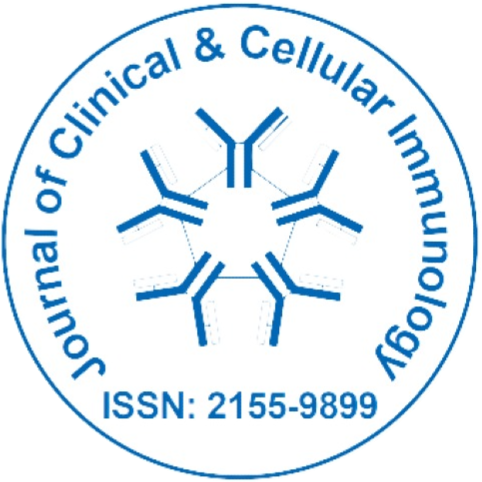
Journal of Clinical and Cellular Immunology
Open Access
ISSN: 2155-9899

ISSN: 2155-9899
Letter to Editor - (2014) Volume 5, Issue 5
We read with interest the excellent article by Zhihui Xie et al., reporting in 35 patients with acute systemic capillary leak syndrome (SCLS) the elevation of several cytokines, including TNFα, compared to both baseline levels as well as sera from healthy controls [1].These results suggest a possible breakthrough in treatment of SCLS, and support a previous report which showed similar increases in three patients with SCLS, as well as effectiveness of anti-TNF-α antibodies (6 mg/kg) in the case of a 6-year-old boy [2]. Recently, our group also experienced a similar case of SCLS occurring in an adult with TNFα elevations during acute attack, responding to TNF-α antagonist (infliximab).
The patient, a 62-year-old Japanese man who had been prescribed an epinephrine auto-injector for idiopathic anaphylaxis characterized by recurrent episodes of nausea, peripheral edema, and hypovolemia, was admitted to our hospital with hypotension. He reported no allergies to foods or medications and reported no unusual exposures. On examination, his systolic blood pressure was 75 mmHg, pulse rate was 58 beats/min, and temperature was 36.4. Neither wheezing nor rashes were observed. He was admitted to the intensive care unit due to insufficient response to initial treatment with 0.3 mg of intramuscular epinephrine, 3.5 Lof intravenous fluids, and 500 mg of intravenous hydrocortisone. Based on his severe shock status, hemoconcentration (hematocrit, 57.3%), hypoalbuminemia (serum albumin, 1.7 g/dL), lack of identifiable triggers despite intensive investigation, and presence of a monoclonal gammopathy (IgG kappa) already noted at a previous hospital, the patient was diagnosed with SCLS. The acute attack was managed with extensive fluid resuscitation and continuous administration of adrenaline; he was subsequently discharged in good condition with a prophylactic regimen of terbutaline plus theophylline. Twelve days after discharge, he was readmitted for a recurrent episode of acute, anaphylaxis-like hypotension. Despite treatment with 12 L of intravenous fluids, in addition to adrenaline, dopamine at 0.35 μg/kg/minute, two 250 mg doses of hydrocortisone, an H2 blocker, leukotriene modifying therapy, and theophylline, his condition did not improve. On the second day of admission, he was intubated due to respiratory failure. Worsening hemoconcentration (hematocrit, 59.3%), hypoalbuminemia (serum albumin, 1.5 g/dL), and renal failure did not respond to the additional infusion of IVIG (400 mg/kg). The patient subsequently went into pulseless electrical activity, requiring six cycles of cardiopulmonary resuscitation before pulse was recovered. Given his persistent shock status (pH 6.8; lactate 14 mmol/L), he was given infliximab at 3 mg/kg. Although his condition did not respond to the initial infusion of infliximab, a second dose of 3 mg/kg, given 30 minutes later, elicited a dramatic clinical response and increase of blood pressure was observed. On the 22nd day of admission, he was discharged home without any sequellae.
This is the first report of successful treatment of an adult case of SCLS with the TNF-α inhibitor, infliximab. During acute attacks, SCLS is a potentially life-threatening disease due to both ischemic organ failures from hypo perfusion during the extravasation phase, as well as flash pulmonary edema in the recovery phase [3]. The estimated five-year survival is reported to be 30-76% [4]. Limited data have suggested that a prophylactic regimen of terbutaline plus theophylline or intravenous immunoglobulin might decrease frequency of attacks [5]. In addition, for treatment of the acute phase of life-threatening SCLS, some authors have reported using a combination of terbutaline and intravenous aminophylline [2] or high doses of IVIG [6]. However, as fulminant acute attacks refractory to these therapeutic agents may occur, establishing optimal salvage therapy is necessary. TNF-α, known to stimulate the release of endothelial cytokines and increase vascular permeability, may play a role [7]. As such, our patient has also continued to receive infliximab as maintenance therapy every 2 months. Although he experienced a recurrent acute attack immediately prior to a subsequent infusion, as well as an isolated attack occurring 4 days after an infusion, serum TNF level were noted to be elevated in both of these instances at 12.5 pg/ml and 11.7 pg/mL, respectively (normal range, <1.79 pg/mL); administration of additional infliximab (3 mg/kg) lead to quick recovery in both episodes. Zhihui Xie et al., also report a 45 year-old male on infliximab for maintenance therapy [1]. Our case, in combination with the previous paediatric report, strongly suggests that TNF inhibitors may be an excellent therapeutic option for both the induction and maintenance treatment of refractory SCLS.
We thank Dr. Masatomo Kiyota (Department of General Internal Medicine, AsoIizuka Hospital, Fukuoka, Japan), who provided expert clinical advice, and Dr. Masahiro Uni (Department of Hematology & Oncology, The University of Tokyo Hospital), who performed a perfect cardiopulmonary resuscitation.